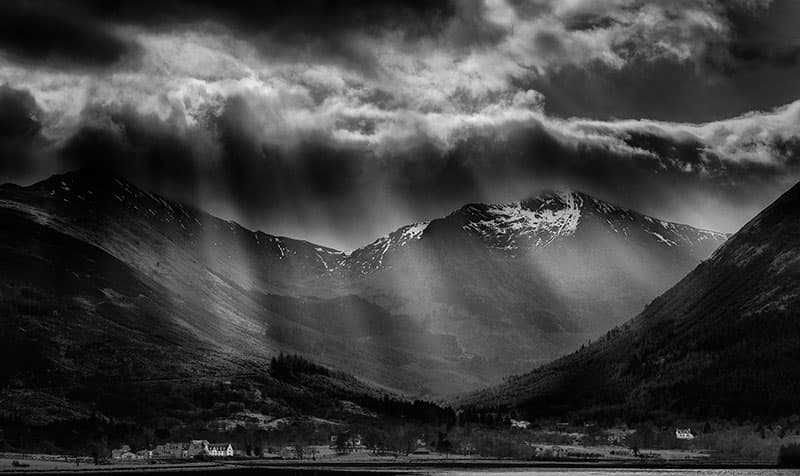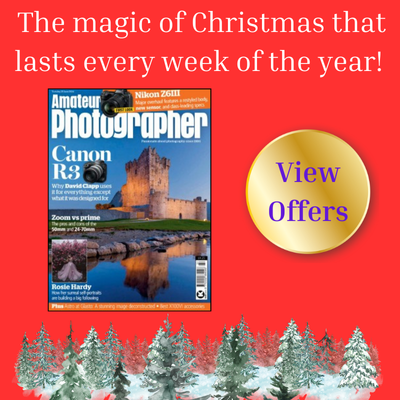 David Byrne is an established landscape photographer who has received distinctions from the International Federation of Photographic Art and the Photographic Alliance of Great Britain, among others. He specialises in monochrome landscapes, emphasising the artistic, creative side of photography.
David Byrne is an established landscape photographer who has received distinctions from the International Federation of Photographic Art and the Photographic Alliance of Great Britain, among others. He specialises in monochrome landscapes, emphasising the artistic, creative side of photography.
As well as some meticulous post-processing, making this image required a day’s shopping in Edinburgh and an hour in a car park. David Byrne tells the story
This image was taken in the Scottish Highlands. Just out of Glencoe there’s a little village with a loch, and that’s where I took this photograph. Actually, it was a special trip – my wife wanted to go to Edinburgh, so I said I’d go with her if she then let me go to Rannoch Moor to take photographs!
We had our day in Edinburgh (a shopping day, with no cameras allowed) and afterwards we went for my day at Rannoch Moor. I got up early to be greeted by no sunshine and lots of rain. The morning was a washout, but it started to pick up in the afternoon. By then I’d finished my attempt at a morning shoot at Rannoch and I was driving around looking for things to photograph. I saw this scene just as I was driving past a petrol station. All the rays came out from between the clouds, with the mountains framing them really well, and I thought, ‘Right. I’m having that one!’
I did a U-turn and suggested to my wife that we stop at the petrol station for sandwiches. We ended up sitting in the petrol station for an hour waiting for the crepuscular rays to appear again. I got everything set up and ready to go, so it was just a case of waiting and being patient. It really did take an hour – and my wife was getting quite annoyed with me – but finally ‘God’s Fingers’ came out and I ran out of the car to get the shot.
I was using a Nikon D700, without a tripod, as I didn’t fancy putting it up in the middle of a petrol-station car park! Although I can’t definitively remember which lens I used, I would bet my bottom dollar that it was a 24-70mm, as that’s more or less what’s stuck to my camera permanently. Having 24mm on a full-frame camera is fantastic – I love it.
This really is my style of photography. I do like to make monochromes very heavy compared to normal middle greys. I like to have lots of extremes, and in this picture, because of the rays, there are very light parts and very dark areas. I did have to do quite a lot of dodging. I use exposure layers, and do all my processing by hand, painting masks in manually. That’s how I get that strong contrast.

I always start my processing in the same way, by processing the raw file in Lightroom so I get a good even balance. If there are any excessive highlights I use the raw tools to bring them back. Once I’ve got the image to a satisfactory base level, I’ll take it into Photoshop and then create two exposure layers. One will be set to ‘Screen’, to give me the highlights but leave the lows unaffected, while the other layer is set to ‘Soft Light’, which boosts the blacks without killing the highlights. I invert both the masks and then use a soft brush to manually paint in where I think the image should be dark and where I think it should be light, judging it by eye. The opacities can be set from 10-50%, depending on how strong I want the effect.
I don’t trust filters because they produce a global filtering effect and it kills photographs. Silver Efex is a great plug-in, but it will kill highlights if you don’t handle it in the right way. Essentially, what I’m doing is performing the same function as Silver Efex, but manually, as I want to control every single pixel.
The handful of houses near the bottom of frame are in the village near. There are just a few houses scattered in the valley, but I wanted to pick out some of them in order to give the photograph scale. It’s a way of showing just how epic these mountains are.
It was a very deliberate choice to have the houses at the bottom because it made everything else look so tall. I could have included some of the loch as well, but decided to crop that out. Originally, there was probably another inch or so at the bottom of this image where you could see some of the water, but it was too bright. The light of the water drew your eye away. I know this is a picture made up of many elements, but that was just one too many.
I think my style of photography is probably more traditional black & white landscape than you might see in the camera club scene. I wouldn’t say it’s groundbreaking in any way – there are plenty of people who have this style – but it’s not what you would generally see in landscape photography. In some clubs, and in awards like Landscape Photographer of the Year, you tend to get what I call record shots, where they haven’t put any emotion into the picture. It’s just about getting a crisp, perfect image. Well, that’s not me. I’m very much about putting the art into it and getting a bit of mood.
You can see more of David’s images on his site: www.85mm.co.uk
David Byrne was talking to Jon Stapley







